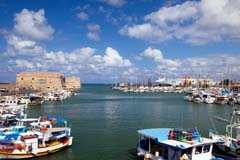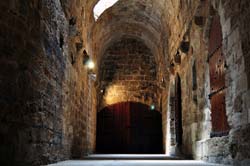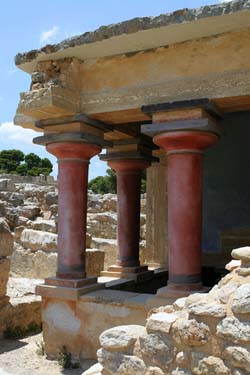You need to upgrade your Flash Player
Please visit Adobe's Flash Player site to upgrade the most recent version.
Thank you.
If you are having issues with installing Adobe Flash Player, please make sure that all "pop-up killer" applications are turned off and you reinstall
the Adobe player.
Heraklion, Crete

About Heraklion prefecture
general information
- Heraklion is a prefecture in Crete island
- Area: 2,648 square km
- Population is approximately 303,250 inhabitants
- Capital of Heraklion is Heraklion Town
- Main port is in Heraklion Town
- Connected with Piraeus port of Athens
- Connected via ferry with some Cycladic islands
- Connected with Athens Athens International Airport via Heraklio and Chania

 Neighbouring with Rethymnon and Lassithi, Heraklio is the business centre of Crete, with its capital being Crete's largest town, populated by approximately 135.000 inhabitants. A very busy and not so attractive town, but with many interesting sites to see. The city is built by the sea. It has a very good nightlife, bars, clubs and cafes as well as restaurants and taverns, since it gathers many University and technical school departments with lots of young people.
Neighbouring with Rethymnon and Lassithi, Heraklio is the business centre of Crete, with its capital being Crete's largest town, populated by approximately 135.000 inhabitants. A very busy and not so attractive town, but with many interesting sites to see. The city is built by the sea. It has a very good nightlife, bars, clubs and cafes as well as restaurants and taverns, since it gathers many University and technical school departments with lots of young people. Among its main sites are the well preserved Venetian town walls. A good ideal of the town's atmosphere is given by the central square - Platia Venizelou - in which stands the Morosini Fountain, the emblem of Heraklio.
You should visit the Archaeological Museum in Platia Eleftherias, the square linked to Platia Venizelou by a pedestrian street.
 Knossos Palace
Knossos Palace The site of Knossos is located 5 km south-east of Heraklio and is a site every visitor in Crete should go to. Excavated and restored by the archaeologist Arthur Evans, it took over 40 years for the whole palace to come to light. It is perhaps the most representative of the Cretan civilization.
The entire palatial complex consisted of around 1400 rooms and was the ruling, administrative and ritualistic centre of Crete between 2000 and 1450 BC. Some of the buildings had as many as four storeys and the palace was built around a central courtyard, 53m long and 28m wide. This was probably a place where people came to watch ritualistic games and the culmination of splendid processions.
A Procession Corridor, so-called because of the frescos depicting a procession painted on its walls, led out from the western courtyard of the palace and into the central courtyard. On its western side Evans uncovered several interesting small rooms. The arrow-shaped crypt is thought to have been a chapel, and the rooms leading off it treasure stores.
Access to the Throne Room is via an outer chamber lined with stone benches with a porphyry bowl at its centre. The throne itself was made of alabaster and is encircled by more stone benches.The throne might have been reserved for a god, as was the case with the "throne of Isis" in Egypt.
No written records about life in Knossos in Minoan times have ever been found, so any calculations drawn from the excavations about daily life, customs and culture are mostly speculative.
In the north-eastern section of the site there is a theatre area surrounded by white steps which provided seating for about 500 people, although there is no evidence of the nature of the performances people came to watch. A path leads from this area to the outlying remains of the "Little Palace". The function of this palace is unknown.
It is thought that in around 1500 BC the population of Knossos numbered around 10.000. It was served by the harbour at Amnissos.
When the Minoan empire collapsed around 1450 BC following natural catastrophes connected to the volcanic eruptions of Santorini, the ruins remained inhabited for some time. They must have been as impressive to the Achaeans and Dorians who followed as they are to us today. It is also possible that the intricate layout of the palace, with its winding, impenetrable passages and rooms, inspired the myth of the Minotaur in the labyrinth. Today the mysteries of the labyrinth have been unfolded for tourists.

